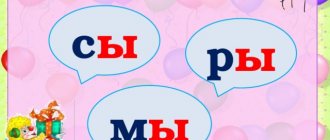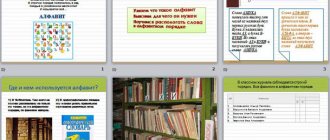Summary of the final lesson with children on learning to read and write
SOFTWARE CONTENT:
CONSOLIDATING THE PASSED MATERIAL: 1. Strengthen children’s understanding of a word and a sentence. 2. To consolidate children’s understanding of a syllable as part of a word, to practice distinguishing the number of syllables in a word by the number of vowels. 3. Develop the ability to recognize sounds and letters. 4. Clarify ideas about the essential features of vowels and consonants. 5. Summarize children’s knowledge about the hardness and softness of consonant sounds. 6. Repeat the rules for writing cha - sha, chu - schu, zhi - shi. 7. Continue to teach children to invent and add words based on a separate part of the word; train children in reading words and text. 8. Build skills in educational activities, develop cognitive interests. 9. Cultivate sustained attention, observation and desire to learn at school. EQUIPMENT: - table of syllables; — table “sound clock”; - cards with words; — pictures: cat, bus, tiger, apple, goose, boat; — cards: blue and green; - cards: wardrobe, sofa, window, chair, lamp.
Progress of the lesson:
Educator: Children, yesterday I received a huge letter, guess who sent it? D.: Dunno! V.: Yes, this is Dunno. He sent an unusual letter, but a letter with tasks and questions that he himself could not answer. And asks you for help. I hope we will not refuse and will try to complete all the tasks that Dunno sent us (on the board there is a portrait of Dunno and an envelope with tasks).
Task No. 1. “Find the word”
V.: The hut in which the watchman lives? D.: Guard! Q: Decoration in the ears? D.: Sergius! Q: Is there a solid clasp on the belt? D.: Buckle! Q: Part of a table or chair? D.: Leg! V.: Children, what did we call you? D.: Words. V.: Children, let's read what is written on the board (read). What have we read again? D.: Words. V.: Okay. Now let's see what is written on the board: “Early spring has come.” What have we read? D: This is a proposal. Q: What does our offer consist of? D: A sentence consists of words. Q: How many words are there in a sentence? D: Three words. Q: Name the first (second, third) word (children name it). What to put at the end of a sentence. D.: Put a period at the end of the sentence. Q: What letter will we write the beginning of the sentence with? D.: The beginning of a sentence is written with a capital letter. V.: Now let’s draw up a diagram of our proposal. V.: You and I repeated: a word only names some objects, but a sentence reports something, expresses thoughts.
Task No. 2. “Working with syllables.”
1. Dividing words into syllables. — Q: What are words divided into? — D.: On syllables. — Q: What is a syllable? — D.: Part of a word that is pronounced with one impulse of air. - V.: How many syllables are in the word: “spring” - two syllables; “machine” - three syllables; “sparrow” - three syllables; "beetle" - one syllable. (Well done!) 2. Reading syllables according to the table. — V.: Children, make up as many words as possible with the syllables: ma, fa, ra (children make up words with the above syllables). 3. Game according to the table “Who lives in which house?” — V.: Children who live in the first, second, third house (children answer according to the picture). 4. Game "Sound Clock". — V.: Children, name the longest, shortest word (children name). Children divide these words into syllables (children divide). Children, how to turn the small word “onion” into a long one? — D.: Onion! — V.: And now children, be more careful. It is necessary to create new words by adding a new syllable. The guys drank sweet juice. Let’s add the syllable ne, it became sand But but it came, it’s already a sock And if ku, read the piece With the syllable le, - we’ll read it - woods We went there for an hour.
Physical education minute.
And now everything is in order. Let’s get together and do some exercise. Hands to the sides - bent, raised up - waved. They hid them behind their backs and looked back over their right shoulder, then over their left. They sat down together and touched their heels. They stood up on their toes and lowered their hands down.
Task No. 3. “Working with sounds.”
1. Playing with the word “woods”. — V.: How many syllables are in the word “little forest.” — D.: Two syllables. — Q: What sounds does the first syllable consist of? — D.: Sounds “L”, “E”. — Q: What sounds does the second syllable consist of? — D.: Sounds “S”, “O”, “K”. 2. Game “Make the same sound in words.” — V.: Bun, branch, cage, squirrel, cat. What is the same sound in words? — D.: Sound “K”. — V.: Using the “Sound Clock” table, find a word with the sound “C” (children call it). Children, make up a word in which the first sound is “A”. - D.: Watermelon, Bus, Stork, etc. — V.: Children, what is sound? — D.: We pronounce and hear sound. — Q: What is the name of the icon that we use to indicate sound in writing? — D.: Letter. — V.: What is a letter? — D.: We write and hear the letter, this is an icon of sound. 3. Game "Who is more attentive." — V.: Children, guess the girl’s name by the first sounds of the names of objects: Cat Goose Bus Bus Tiger Boat Apple Apple Katya Galya — V.: Children, what sounds are there? — D.: Vowels and consonants. — V.: Who will tell you about vowel sounds? - D-:
Air flows freely through the mouth There are no different obstacles The voice is involved, the voice is a covenant The sound is a vowel. The vowels stretch out in a ringing song, They can cry and scream, They can cradle a child in a crib, But they don’t want to whistle and grumble.
Q: Who will tell you about consonant sounds? d.:
And the consonants... agree to rustle, whisper, creak, even snort and hiss, but I don’t want to sing to them. Ss - a snake whistle is heard, Shsh - a fallen leaf rustles, Zh - bumblebees buzz in the garden, Rr - engines rumble.
Q: Children, what are the consonant sounds? D.: Hard and soft. Q: What vowel sounds indicate the hardness of a consonant? D.: “a”, “o”, “u”, “s”, “e”. Q: What vowel sounds indicate the softness of a consonant? D.: “I”, “e”, “yu”, “i”, “e”. A game. V.: Raise a blue card if the first sound is hard, green if the first sound is soft. Let's get ready. Garden, Senya, Crucian carp, Rice, Beads, Blue, Sit down, Soup.
Task No. 4. “Shrink all objects.”
V.: Children, imagine that we are in the country of gnomes and we need to reduce all these objects: a wardrobe - a cabinet; sofa - sofa; window - window; chair - stool; lamp - light bulb. V.: Today in class everyone worked actively, completed the assignments, answered all Dunno’s questions. The lesson is over.
Author: Valentina Vladimirovna Pronina, teacher, mixed preschool educational institution “Fairy Tale” No. 13, Shchekino, Tula region, Russia
The article is published in the author's edition



